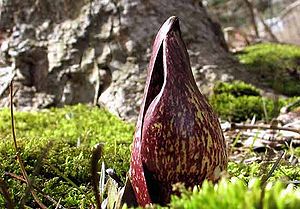Symplocarpus foetidus
| Eastern Skunk Cabbage | |
|---|---|
 | |
| Binomial: | Symplocarpus foetidus |
| Family: | Araceae |
| Type: | Herbaceous |
| Soil requirements: | wet soils |
Eastern Skunk Cabbage, Clumpfoot Cabbage, Foetid Pothos, Meadow Cabbage, Polecat Weed, Skunk Cabbage, or Swamp Cabbage (Symplocarpus foetidus), commonly known as simply Skunk Cabbage, is a low growing, foul smelling plant that prefers wetlands. It can be found naturally in eastern North America, from Nova Scotia and southern Quebec west to Minnesota, and south to North Carolina and Tennessee, and also in northeastern Asia, in eastern Siberia, northeastern China and Japan. It is the only species in the genus, although the genus Lysichiton is similar. Skunk cabbage is protected as a state endangered plant in Tennessee.[1]
Description
[edit | edit source]The leaves are large, 40-55 cm long and 30-40 cm broad. It flowers early in the year; the flowers are produced in a 5-10 cm long spadix contained within a spathe, 10-15 cm tall and mottled purple in colour. It flowers in the early spring, when only the flowers are visible above the mud, with the stems buried below and the leaves emerging later. The rhizome is often 30 cm thick.
Its name is derived from its odor, which is rather mild as long as the plant remains intact. To fully appreciate why the plant is so named, one need only tear off a fresh leaf, releasing a pungent odor. While not considered edible, the plant is not poisonous to the touch. Though unpleasant, the smell is not harmful. The foul odor attracts its pollinators, scavenging flies, stoneflies, and bees. The odor in the leaves may also serve to discourage large animals from disturbing or damaging this plant which grows in soft wetland soils.
Skunk cabbage is notable for its ability to produce heat of up to 15-35° C above air temperature by cyanide resistant cellular respiration in order to melt its way through frozen ground,[2] placing it among a small group of plants exhibiting thermogenesis. Although flowering whilst there is still snow and ice on the ground it is successfully pollinated by early insects that also emerge at this time. Some studies suggest that beyond allowing the plant to grow in icy soil, the heat it produces may help to spread its odor in the air. Carrion-feeding insects that are attracted by the scent may be doubly encouraged to enter the spathe because it is warmer than the surrounding air, fueling pollination. [3]

Eastern Skunk Cabbage has contractile roots which contract after growing into the earth. This pulls the stem of the plant deeper into the mud, so that the plant in effect grows downward, not upward. Each year, the plant grows deeper into the earth, so that older plants are practically impossible to dig up. It is thought possible that it may be able to live for hundreds of years. They reproduce by hard, pea-sized seeds which fall in the mud and are carried away by animals or by floods.
Growing Conditions
[edit | edit source]Does best in true wetlands, but can survive in moist soils. Full sun to fairly dense shade.
Uses
[edit | edit source]In the 19th century the U. S. Pharmacopoeia listed eastern skunk cabbage as the drug "dracontium". It was used in the treatment of respiratory diseases, nervous disorders, rheumatism, and dropsy. In North America and Europe, skunk cabbage is occasionally cultivated in water gardens.[4] Skunk cabbage was used extensively as a medicinal plant, seasoning, and magical talisman by various tribes of Native Americans.[5]
Maintenance
[edit | edit source]Propagation
[edit | edit source]Easily propagated by division, though the plant is quite aromatic in the underground parts.
Pests and Diseases
[edit | edit source]Leaf blights are frequent but not fatal.
References
[edit | edit source]| Wikiversity is collecting bloom time data for Symplocarpus foetidus on the Bloom Clock |
- ↑ USDA PLANTS Database: S. foetidus
- ↑ Thorington, Katherine K.: "Pollination and Fruiting Success in the Eastern Skunk Cabbage", The Journal of Biospheric Science , vol 1 no. 1 April 1999, accessed March 4, 2007, <http://www.mtholyoke.edu/courses/mmcmenam/journal.html
- ↑ Marinelli, Janet: "Turning Up the Heat on Your Property", Backyard Habitat - National Wildlife Magazine, vol. 45 no. 1 Dec/Jan 2007, accessed March 3, 2007, <http://www.nwf.org/nationalwildlife/article.cfm?issueID=112&articleID=1418
- ↑ Flora of North America: S. foetidus
- ↑ Dr. Moerman's Native American Ethnobotanical Database: S. foetidus
- Book:Horticulture/Finder/Types/Plants, Herbaceous
- Book:Horticulture/Finder/Seasons/Spring
- Book:Horticulture/Finder/Seasons/Winter
- Book:Horticulture/Finder/Conditions/Part Shade
- Book:Horticulture/Finder/Conditions/Full Sun
- Book:Horticulture/Finder/Conditions/Wet Soil Tolerant
- Book:Horticulture/Finder/Resistance/Deer
- Book:Horticulture/Finder/Native/North America
- Book:Horticulture/Finder/Flowers/Brown